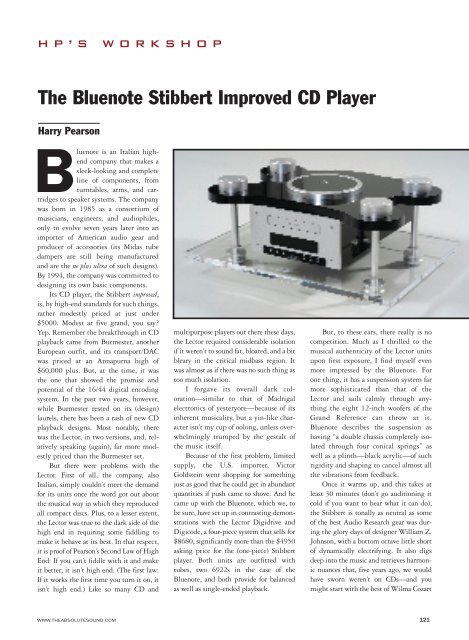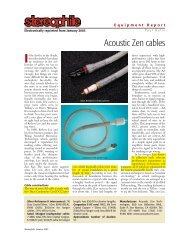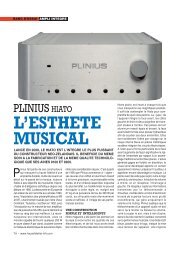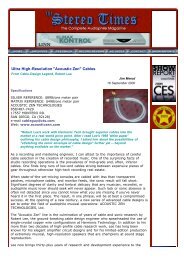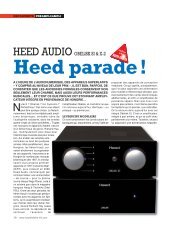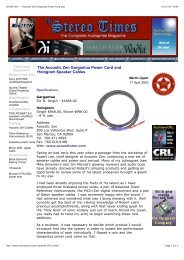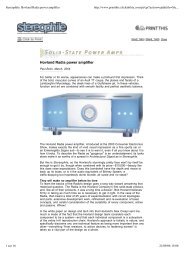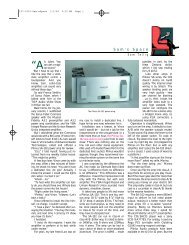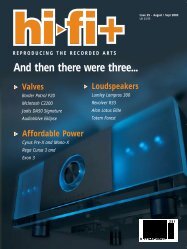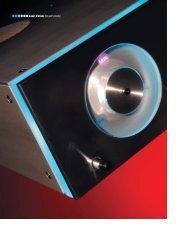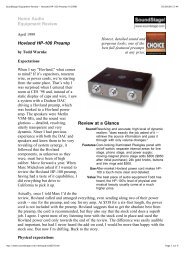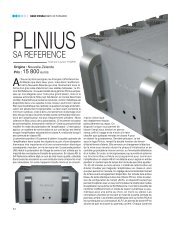The Bluenote Stibbert Improved CD Player - Jason Diffusion
The Bluenote Stibbert Improved CD Player - Jason Diffusion
The Bluenote Stibbert Improved CD Player - Jason Diffusion
- No tags were found...
Create successful ePaper yourself
Turn your PDF publications into a flip-book with our unique Google optimized e-Paper software.
HP’S WORKSHOP<strong>The</strong> <strong>Bluenote</strong> <strong>Stibbert</strong> <strong>Improved</strong> <strong>CD</strong> <strong>Player</strong>Harry Pearson<strong>Bluenote</strong> is an Italian highendcompany that makes asleek-looking and completeline of components, fromturntables, arms, and cartridgesto speaker systems. <strong>The</strong> companywas born in 1985 as a consortium ofmusicians, engineers, and audiophiles,only to evolve seven years later into animporter of American audio gear andproducer of accessories (its Midas tubedampers are still being manufacturedand are the ne plus ultra of such designs).By 1994, the company was committed todesigning its own basic components.Its <strong>CD</strong> player, the <strong>Stibbert</strong> improved,is, by high-end standards for such things,rather modestly priced at just under$5000. Modest at five grand, you say?Yep. Remember the breakthrough in <strong>CD</strong>playback came from Burmester, anotherEuropean outfit, and its transport/DACwas priced at an Annapurna high of$60,000 plus. But, at the time, it wasthe one that showed the promise andpotential of the 16/44 digital encodingsystem. In the past two years, however,while Burmester rested on its (design)laurels, there has been a rash of new <strong>CD</strong>playback designs. Most notably, therewas the Lector, in two versions, and, relativelyspeaking (again), far more modestlypriced than the Burmester set.But there were problems with theLector. First of all, the company, alsoItalian, simply couldn’t meet the demandfor its units once the word got out aboutthe musical way in which they reproducedall compact discs. Plus, to a lesser extent,the Lector was true to the dark side of thehigh end in requiring some fiddling tomake it behave at its best. In that respect,it is proof of Pearson’s Second Law of HighEnd: If you can’t fiddle with it and makeit better, it isn’t high end. (<strong>The</strong> first law:If it works the first time you turn it on, itisn’t high end.) Like so many <strong>CD</strong> andmultipurpose players out there these days,the Lector required considerable isolationif it weren’t to sound fat, bloated, and a bitbleary in the critical midbass region. Itwas almost as if there was no such thing astoo much isolation.I forgave its overall dark coloration—similarto that of Madrigalelectronics of yesteryore—because of itsinherent musicality, but a yin-like characterisn’t my cup of oolong, unless overwhelminglytrumped by the gestalt ofthe music itself.Because of the first problem, limitedsupply, the U.S. importer, VictorGoldstein went shopping for somethingjust as good that he could get in abundantquantities if push came to shove. And hecame up with the <strong>Bluenote</strong>, which we, tobe sure, have set up in contrasting demonstrationswith the Lector Digidrive andDigicode, a four-piece system that sells for$8680, significantly more than the $4950asking price for the (one-piece) <strong>Stibbert</strong>player. Both units are outfitted withtubes, two 6922s in the case of the<strong>Bluenote</strong>, and both provide for balancedas well as single-ended playback.But, to these ears, there really is nocompetition. Much as I thrilled to themusical authenticity of the Lector unitsupon first exposure, I find myself evenmore impressed by the <strong>Bluenote</strong>. Forone thing, it has a suspension system farmore sophisticated than that of theLector and sails calmly through anythingthe eight 12-inch woofers of theGrand Reference can throw at it.<strong>Bluenote</strong> describes the suspension ashaving “a double chassis completely isolatedthrough four conical springs” aswell as a plinth—black acrylic—of suchrigidity and shaping to cancel almost allthe vibrations from feedback.Once it warms up, and this takes atleast 30 minutes (don’t go auditioning itcold if you want to hear what it can do),the <strong>Stibbert</strong> is tonally as neutral as someof the best Audio Research gear was duringthe glory days of designer William Z.Johnson, with a bottom octave little shortof dynamically electrifying. It also digsdeep into the music and retrieves harmonicnuances that, five years ago, we wouldhave sworn weren’t on <strong>CD</strong>s—and youmight start with the best of Wilma CozartWWW.THEABSOLUTESOUND.COM 121


